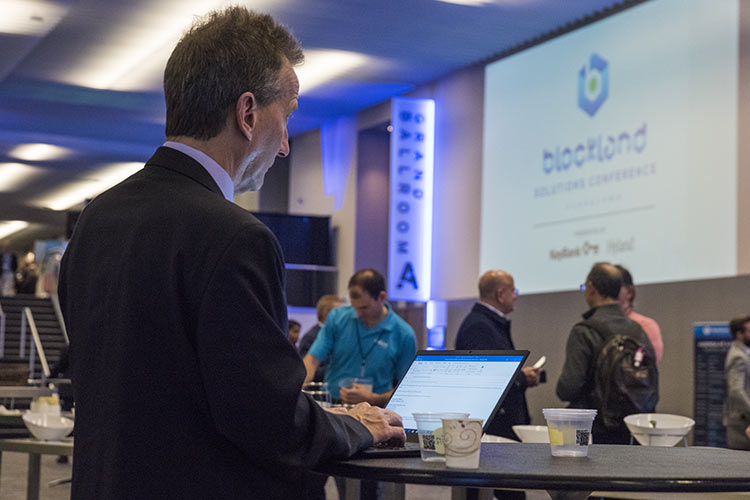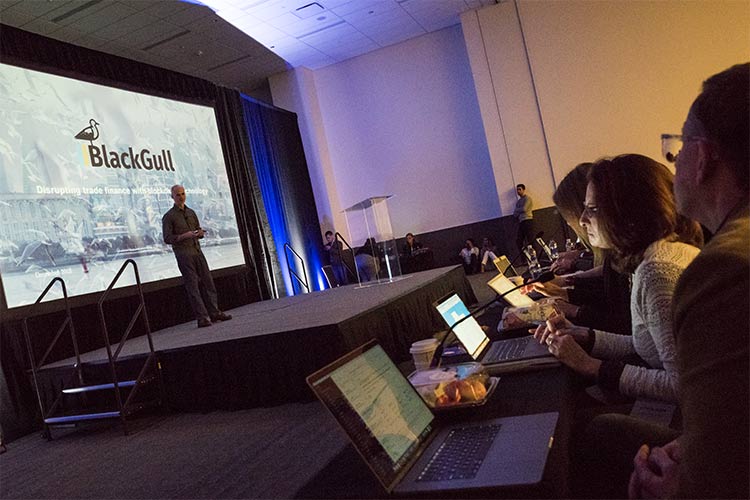
Cleveland's not-so-secret strategy for becoming the next tech hub
A lot can happen in six months. Just ask Steve Santamaria, part of the brain trust behind the blockchain movement currently energizing Cleveland.
In April, Santamaria relocated back to Cleveland after 17 years in Seattle—armed with Silicon Valley cred from spending 14 years at Intel and running two startups. “I wanted to get involved in something in Cleveland, and someone mentioned a meeting with a guy named Bernie [Moreno] who wanted to [elevate] blockchain in Cleveland,” recalls Santamaria.
In late June, Santamaria attended said meeting, but his West Coast sensibilities, well, stood out a bit. “It was all tech guys and lawyers—24 suits-and-ties, and me,” says Santamaria, currently CEO of Folio Photonics. “I don’t even know if I have a tie anymore.”
But when someone brought up the notion of “recreating Silicon Valley in Ohio,” Santamaria knew he was in the right place. Santamaria immediately launched into a litany of ideas and thoughts about how Cleveland could realistically become a center for blockchain, sparking Moreno’s attention.
 “Bernie comes firing over at me during break, and said, ‘Who are you? What’s your story?’” says Santamaria. “The next day, I was committed to co-chairing a thought leadership node and delivering a conference.”
“Bernie comes firing over at me during break, and said, ‘Who are you? What’s your story?’” says Santamaria. “The next day, I was committed to co-chairing a thought leadership node and delivering a conference.”
That “conference” was Blockland Solutions, held December 1-4 at the Huntington Convention Center of Cleveland. With close to 2,000 attendees, the event was a bona fide success—positioning Cleveland as an emerging blockchain leader and attracting experts, entrepreneurs, and companies from around the globe. Speakers included Oracle CEO Mark Hurd, AT&T Communications CEO John Donovan, and KeyCorp Chairman & CEO Beth Mooney.
“We’re trying to establish [the city] as a leader in blockchain, but our broader mission is to establish Cleveland as a tech hub in general,” explains Chantel Moody, Platform Director for Plug and Play Cleveland. “We want to compete with the Austin, Texases of the world, and emerge as a place where you can do business in any type of technology. The idea is to use the up-and-coming popularity of blockchain as a rally cry.”
As Moreno and his cohorts see it, that starts with establishing Cleveland as an epicenter of blockchain. The vision originated with car dealer Moreno, who went on to mobilize an all-star, all-volunteer team of Cleveland movers and shakers—including Moody and Santamaria—to move it forward. That team is now divided into 10 action-focused “nodes,” from Thought Leadership to Research & Innovation.
 Alongside Aaron Slodov (of Remesh), Moody co-chairs the “Next Gen” node, which has four sub-committees and meets once per month. The node is geared at ensuring retention of young tech talent and helping educate youth. Since the node formed, Moody says they’ve added 100 members under 35 years old. At the Blockland Solutions conference, they programmed a “Startup Alley” with 34 global startups and a corresponding pitch competition with $20,000 in prizes.
Alongside Aaron Slodov (of Remesh), Moody co-chairs the “Next Gen” node, which has four sub-committees and meets once per month. The node is geared at ensuring retention of young tech talent and helping educate youth. Since the node formed, Moody says they’ve added 100 members under 35 years old. At the Blockland Solutions conference, they programmed a “Startup Alley” with 34 global startups and a corresponding pitch competition with $20,000 in prizes.
“The goal was to advance business development talks and share investment opportunities,” says Moody. “We wanted to create a catalyst for getting companies to come back to Cleveland to do business.”
Flashstarts also shares that goal, having announced at the conference that it will launch a $6 million blockchain startup investment fund—the first in the region and one of few early-stage blockchain funds in the world. “We need to make people and businesses interested in playing in this new sandbox,” says partner Charles Stack. “Attracting blockchain startups here is really the key.”
Stack believes the next wave of blockchain interest after bitcoin will be based around Ethereum, a decentralized platform that enables “smart contracts.”
“Bitcoin is a cryptocurrency, but Ethereum is a very different animal,” explains Stack. “It’s a programmable database and a whole new way of looking at information.”
For instance, Stack says Ethereum can connect various databases and entities to create a singular, seamless workflow. The end result might be a much quicker process for buying a house (closing in just a few days instead of a month), being able to better track royalties or licensing, or integrating medical records across providers to give doctors a better picture of one’s medical history.
“With Cleveland being a medical hub, that’s one of the reasons it makes a lot of sense for Northeast Ohio to focus on blockchain,” says Stack.

Though it might seem like a steep learning curve to master such technology, both Santamaria and Stack say that’s not the case. Stack estimates it takes just six months of coding education to learn blockchain, while Santamaria says, “You don’t need to have a degree from Stanford or MIT to create blockchain solutions. Because it’s not super high-tech, a city like Cleveland getting in early and getting a few wins could easily make it a center of excellence.”
Santamaria points to Pittsburgh as a good template for how a city can position itself as a leader in a certain tech niche. “Pittsburgh got National Science Foundation grants around artificial intelligence and autonomous cars and robotics—now they’re a leader in those areas,” he says.
 Moody thinks Cleveland can follow suit when it comes to blockchain, largely because of the way diverse talent has come together—from many companies and organizations, all on a volunteer basis—to make it happen.
Moody thinks Cleveland can follow suit when it comes to blockchain, largely because of the way diverse talent has come together—from many companies and organizations, all on a volunteer basis—to make it happen.
“It’s truly a group decentralized effort,” says Moody. “In the past, we’ve been very silo-ed. No one has really worked together on one initiative like this, so this is the first time it’s been done on this scale.”
The payoff is starting to take shape. Planning for the second conference is already underway, and the “Place” node—led by Jon Pinney—is preparing to make a major announcement in early 2019. “The plan is to revamp a building in Cleveland and make it an innovation hub for [blockchain] corporates, investors, and startups,” says Moody. “It will be our version of 1871 in Chicago or Station F in Paris.”
It's an exciting time for tech workers in Cleveland, or anyone interested in blockchain, really.
"This is like the early stages of the Internet in 1994," says Stack. "For those people who think they may have missed the Internet wave—either from understanding, opportunity, or investment—this is a chance to not miss the next one."












